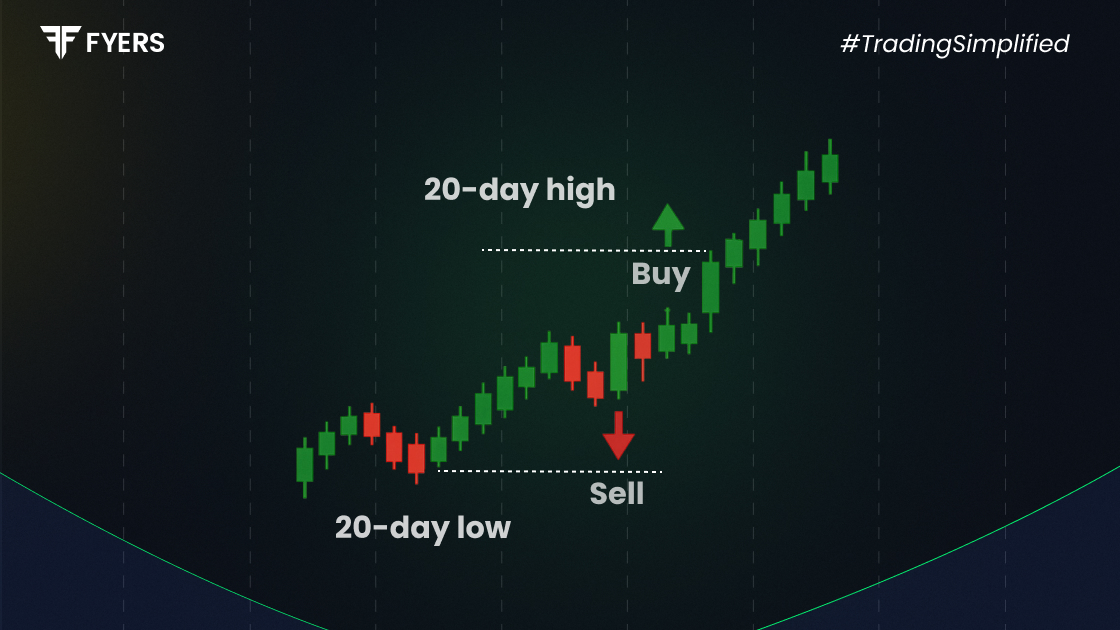

 17 Jul, 2025
17 Jul, 2025
 4 mins read
4 mins read

The legendary 1980s Turtle Trading experiment proved that anyone could learn to trade by following strict rules. But decades later, does this classic turtle trading strategy still work in dynamic markets like India? In this article, we look at where it came from, how it works, and what backtesting shows when used on Indian stocks.
The turtle trading concept began with an experiment by renowned commodities trader Richard Dennis. Dennis believed trading success was more about discipline and following a tested system than instinct. To show this in practice, he trained a group of beginners known as the “Turtles” to trade by following strict rules later shared in the Turtle Trader book.
Richard Dennis’s trading strategy focused on a simple idea: capturing major trends by entering at breakouts and strictly managing risk. This systematic method turned many Turtles into successful traders, making it one of the most famous stories in trading history.
The turtle trading strategy was designed to capture large price movements and included:
Entry & exit rules: Buy when price breaks above a certain period high; sell when it breaks below a certain period low.
Position sizing: Allocate positions based on market volatility (using Average True Range).
Risk management: Limit losses with stop-loss orders; never risk more than a set percentage of capital on one trade.
This clear, rule-based method helped traders stay disciplined even when markets turned volatile.
The complete turtle trader approach is highly systematic, aiming to profit from strong trends rather than frequent short-term moves. But applying it directly to Indian markets isn’t always straightforward.
Indian stocks often have higher volatility, lower liquidity in mid-cap and small-cap segments, and face unique regulatory factors (like circuit limits). These differences mean that a strategy built for highly liquid US futures might behave differently in India, especially during sideways markets.
To see how the turtle trading strategy performs in India, backtesting can help. Here’s an outline of a typical approach:
Time period: Example, 2010–2023 to cover different market cycles.
Universe of stocks: Large-cap Nifty 50 and selected liquid mid-caps.
Parameters tested: Breakout periods (e.g., 20-day and 55-day highs/lows), volatility-based position sizing, and fixed stop-loss.
Tools used: Excel, Python, or specialized backtesting platforms.
By simulating trades based on past data, we can analyze how the system would have performed historically.
Here’s what backtesting shows (illustrative results):
|
Metric |
Result (Example) |
|---|---|
|
Win/Loss Ratio |
Around 35–40% |
|
Annualized Returns |
10–15% (before costs) |
|
Maximum Drawdown |
-25% to -35% |
|
Benchmark (Nifty) |
~12% annualized in same period |
Key takeaways:
The system captures major trends but often struggles in sideways markets, which leads to several small losses.
Drawdowns can be significant, testing the trader’s patience.
Transaction costs and slippage may reduce returns, especially in illiquid stocks.
Charts comparing strategy equity curves vs benchmark can add more clarity (and boost turtle finance content relevance).
Like any system, turtle trading has its advantages and limitations:
Brings discipline to trading by following clear rules.
Reduces emotional decision-making.
Can capture large market moves when trends are strong.
Whipsaws in choppy markets may lead to frequent small losses.
Higher transaction costs in Indian markets can eat into profits.
Requires patience and strict adherence to rules.
Including risk management concepts from turtle finance helps traders manage volatility and stick to their plan.
The success of the Turtles wasn’t just about the rules — it was about following them. Here’s what stands out from the richard dennis trading strategy:
Discipline matters more than prediction: Following tested rules can outperform guessing market direction.
Risk management is essential: Surviving drawdowns keeps traders in the game.
Trade trends, not noise: Focus on capturing large, sustained price movements.
These lessons are still relevant, even decades later.
Turtle trading can work for some Indian investors, especially those who:
Prefer systematic, rules-based trading.
Have enough capital to diversify and manage volatility.
Are comfortable holding positions through trends rather than trading daily.
Adaptations like longer breakout periods, adjusted stop-loss levels, or focusing on the most liquid stocks can help improve performance. But beginners should be cautious, backtest thoroughly, and never risk more than they can afford to lose.
The original turtle trading experiment proved that trading success is teachable and rule-based systems can work. In Indian markets, backtesting shows it can capture trends but may face challenges during sideways periods or with higher costs.
For modern traders, combining the complete turtle trader approach with personal research, updated parameters, and risk management keeps the spirit of the system alive. Like the Turtles, patience and discipline remain the keys to success.
A trend-following system created by Richard Dennis and William Eckhardt, using fixed entry & exit rules to capture large market moves.
It can work in trending markets but may underperform in sideways conditions common in Indian stocks.
Discipline, systematic risk management, and sticking to proven rules matter more than predicting markets.
As part of his famous experiment, Richard Dennis designed it to test whether people could be taught to trade.
Calculate your Net P&L after deducting all the charges like Tax, Brokerage, etc.
Find your required margin.
Calculate the average price you paid for a stock and determine your total cost.
Estimate your investment growth. Calculate potential returns on one-time investments.
Forecast your investment returns. Understand potential growth with regular contributions.